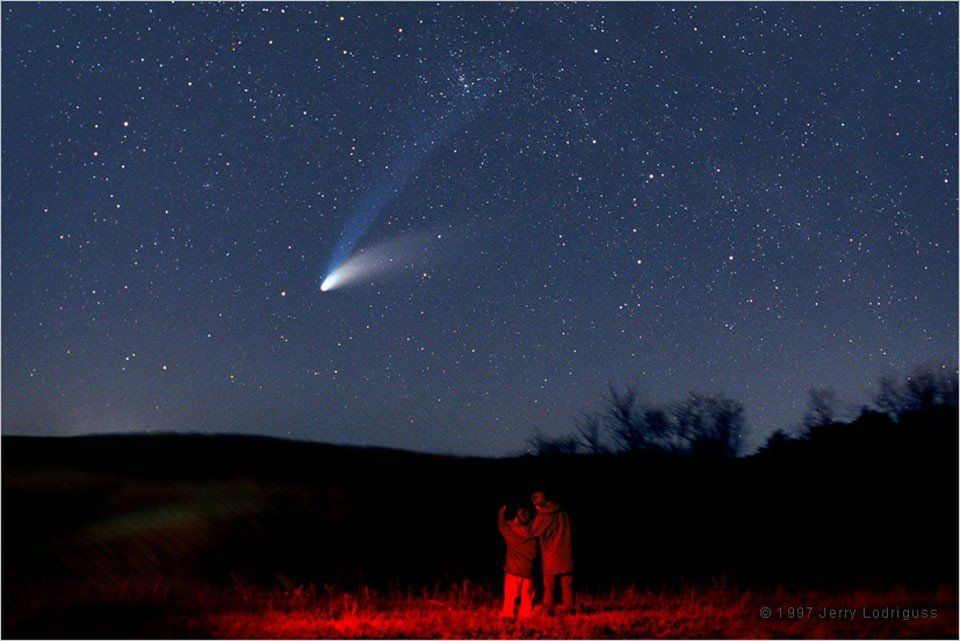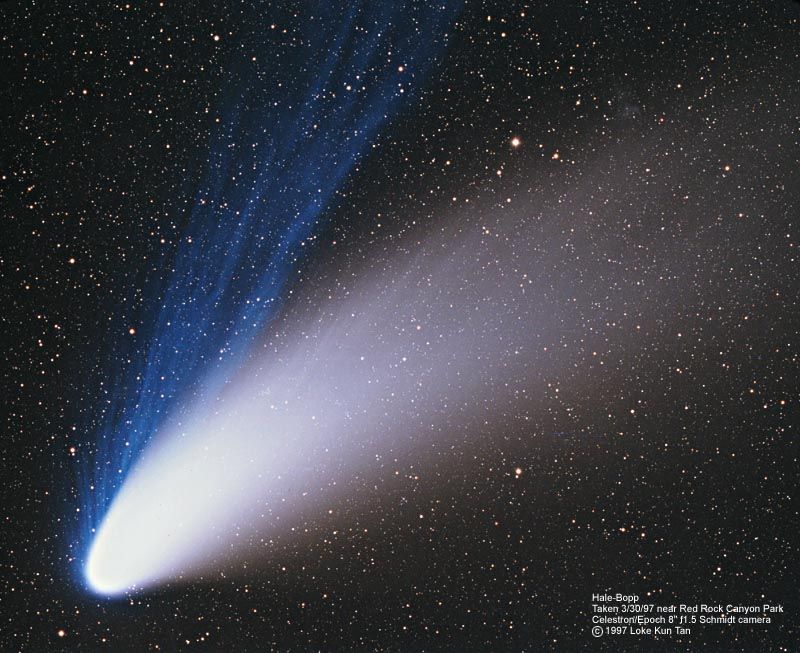This web page is created within BALTICS project funded from the European Union’s Horizon2020 Research and Innovation Programme under grant agreement No.692257.
Comet Hale-Bopp
The Great Comet of 1997 – Comet Hale-Bopp, which is probably the most widely observed comet in the 20th century, got its name. The comet reached perihelion on April 1, 1997. With the naked eye, it could be observed for 18 months, about 2 times longer than the previous record holder – the Great Comet of 1811.
On July 23, 1995, two hobby astronomers, Alan Hale and Thomas Bopp, spotted the comet independently of each other. Hale has been searching for comets for a long time, but so far he hasn’t had any luck. Bopp, who didn’t even have his own telescope, explored the sky in Arizona with friends when he spotted a “blurred cloud” near the M70 globular cluster. Both discoverers made sure that no other space objects were known in this area of the sky, and reported the finding. In mid-March, its observed star size reached only a quarter and its tail was relatively short.
The comet was unusually active and well visible at great distances from the Sun. Astronomers have estimated that the comet’s core could be more than 40 km large. This gave hope that the comet would be well visible to the naked eye, although scientists were cautious. Often, the initial activity suggests that a “comet of the century” is expected, but later the comet not only becomes dull, but sometimes disintegrates, disappointing the general public.
However, the Hale-Bopp comet did not disappoint. In May 1996, it could already be seen with the naked eye. The comet gradually became brighter, although slower than expected. In December 1996, the comet was not visible from Earth because it was too close to the Sun, but when it became visible again in January 1997, it was clear that it would not disappoint. The comet could be seen by anyone, even those living in brightly lit cities.
More popularity to the comet gave the more widely available Internet, with countless websites offering both information and the latest images. NASA’s website was visited by 1.2 million readers every day during the 1997 Easter holidays.
In February 1997, the comet had a star size of +2 and had two tails. During the solar eclipse of March 9, people could see the Hale-Bopp comet during the day. Around the time of perihelion, the comet was indescribably beautiful, surpassing the stars in its brilliance and a long tail behind it was stretching.
This time the success was on the side of the people of the northern hemisphere, because they had the most impressive part of the show. After perihelion, the comet was visible in the southern hemisphere. The comet slowly faded. December 1997 was the last time it could be seen with the naked eye.
The Hale-Bopp comet belongs to the long period comets. It is estimated that previous visits to the internal areas of the Solar system may have occurred about 4,200 years ago.
In 1996, the comet flew relatively close to Jupiter. The gravity of a giant planet changed the orbit of a comet. The orbital period decreased to 2533 years. The next time Hale-Bopp comet will be near Earth in about 4385.
The gases emitted by the Hale-Bopp comet were also analyzed to find an answer to the question of where the water came from on Earth. The obtained results revealed that the isotopic composition of ice of comet water (heavy hydrogen or deuterium relative to hydrogen) does not correspond to the isotope ratios of the Earth’s oceans. Both sodium and the noble gas argon, as well as various organic substances (methanol, methane, ethane, formic acid, etc.) were detected in the material emitted by the comet.
The Hale-Bopp comet also became a source of sensation. In 1996, a hobby astronomer noticed an oblong object near a comet in his self-photographed images. He was unable to identify the object with the help of a computer program, so he announced to the local radio that he had detected the object that follows the comet. The news that an alien ship was flying behind the comet spread quickly around the world. The saddest turn in the story came in March 1997, when nearly 40 members of the Heaven’s Gate cult committed suicide to “teleport” to this imaginary “spaceship.”





















